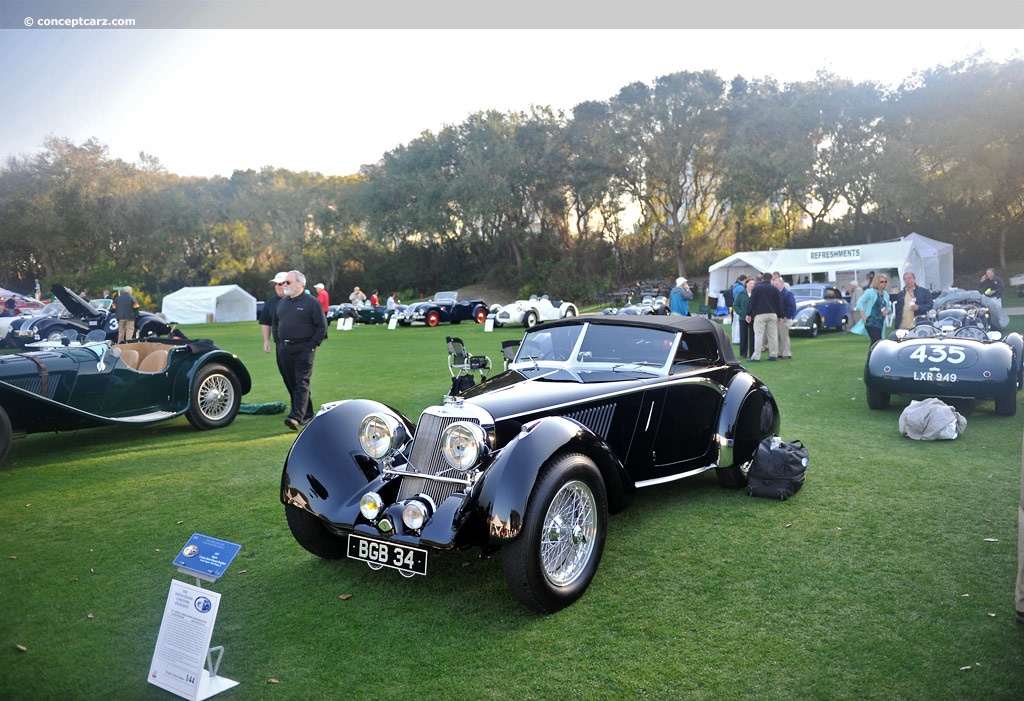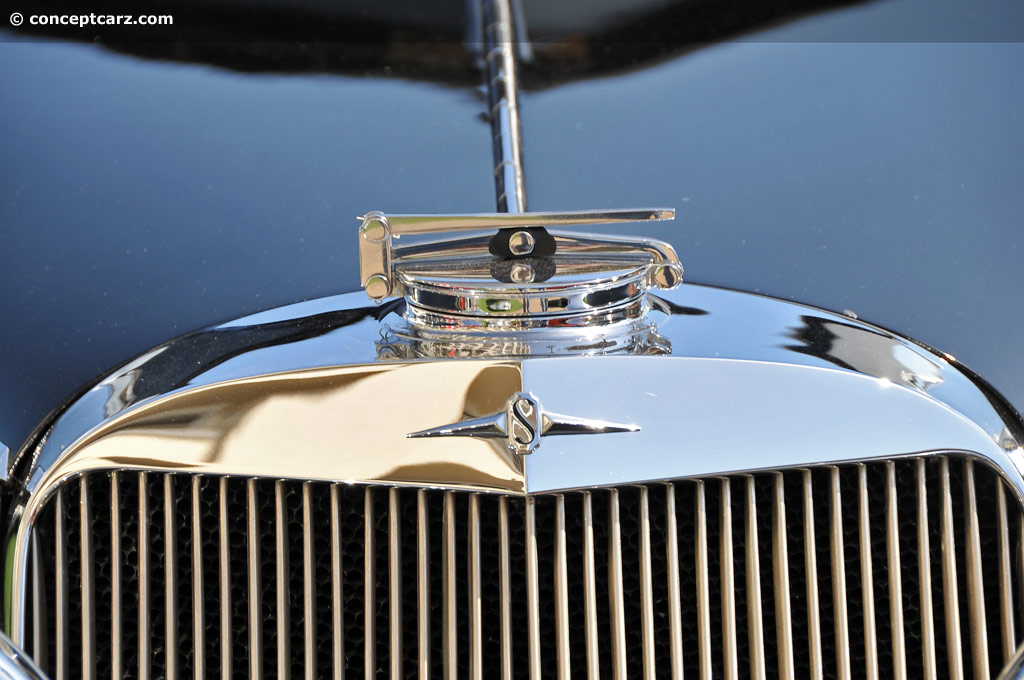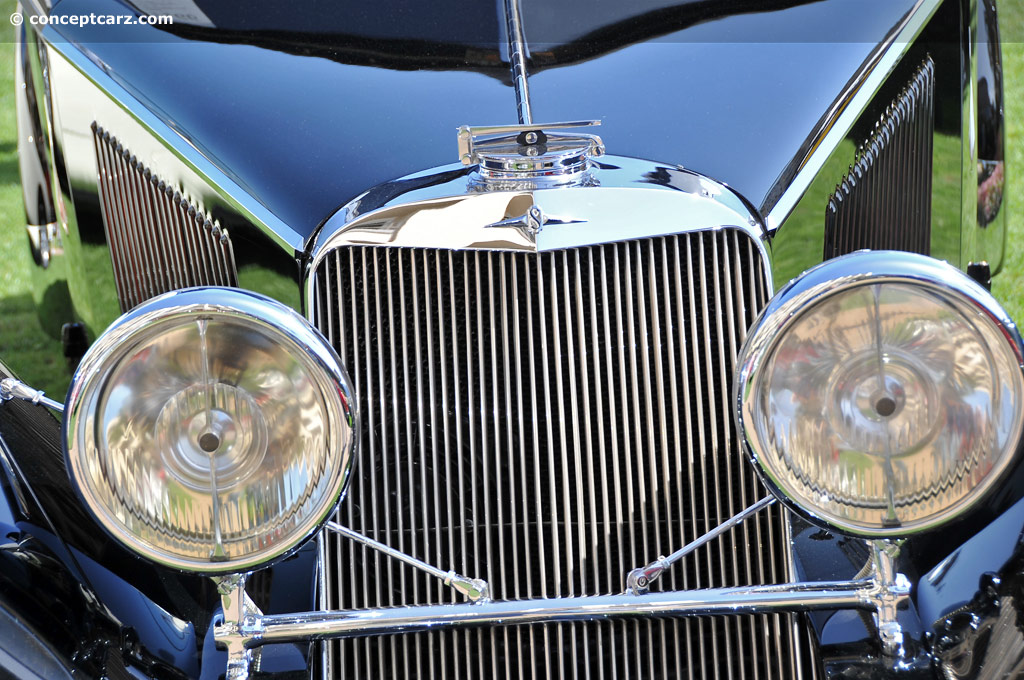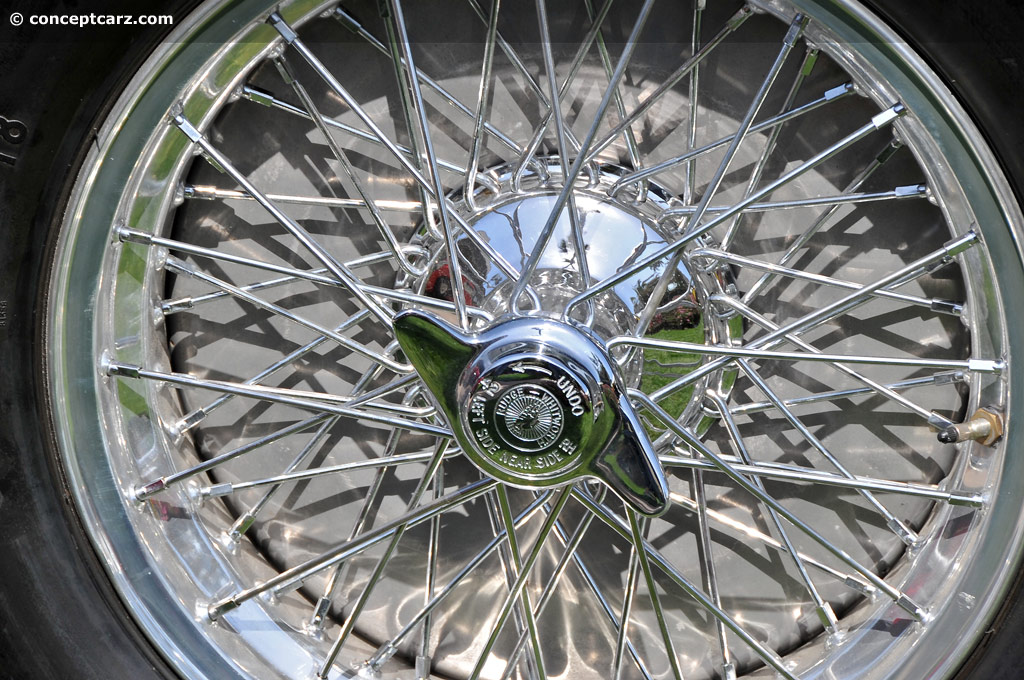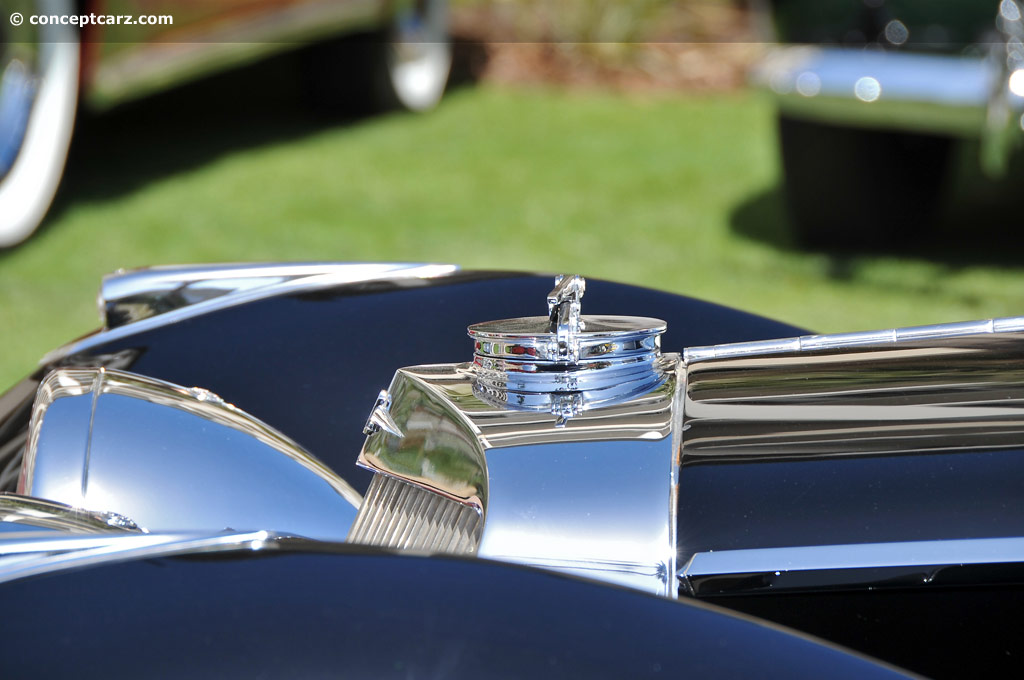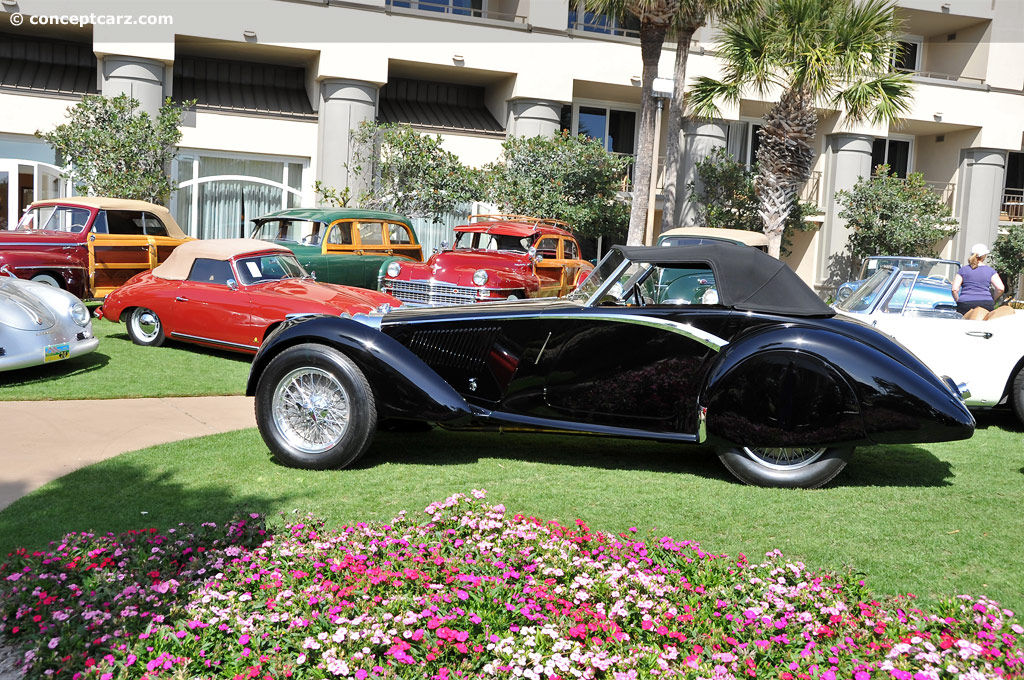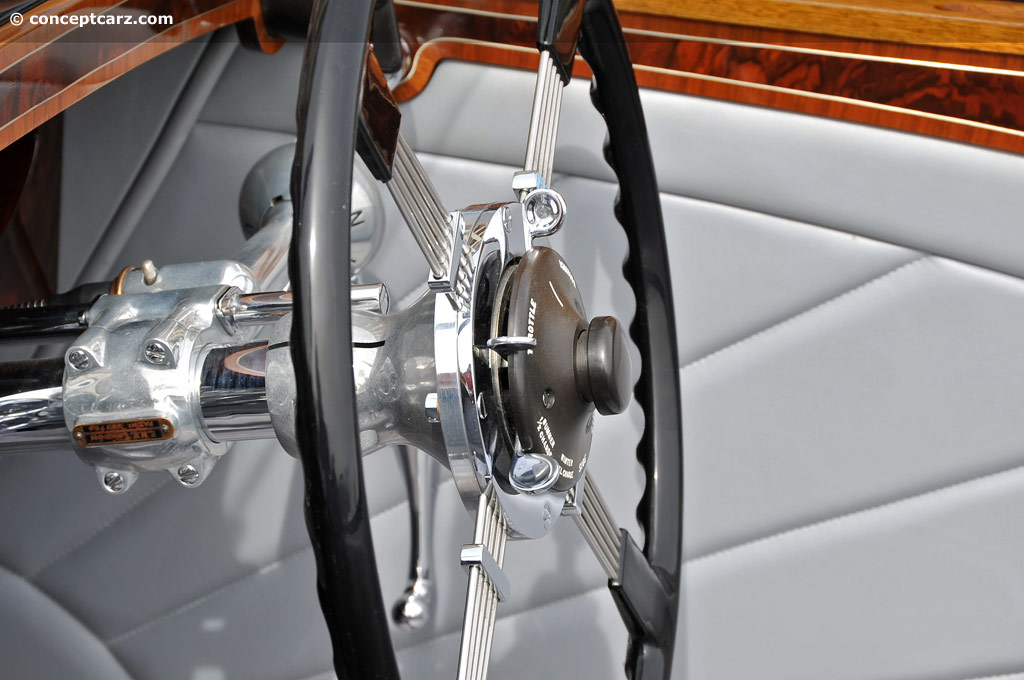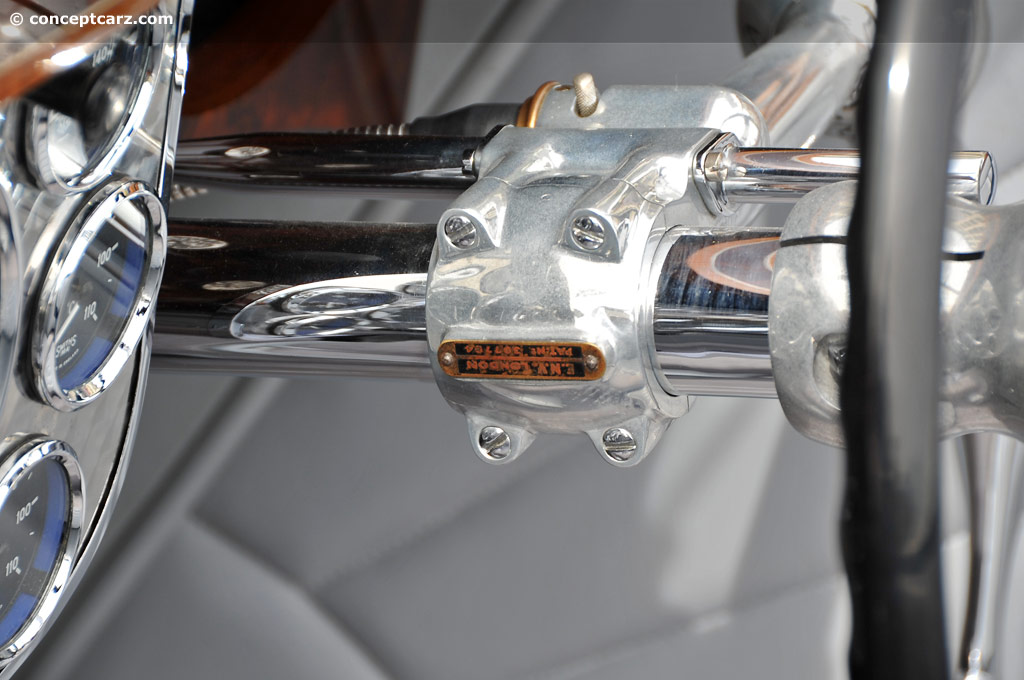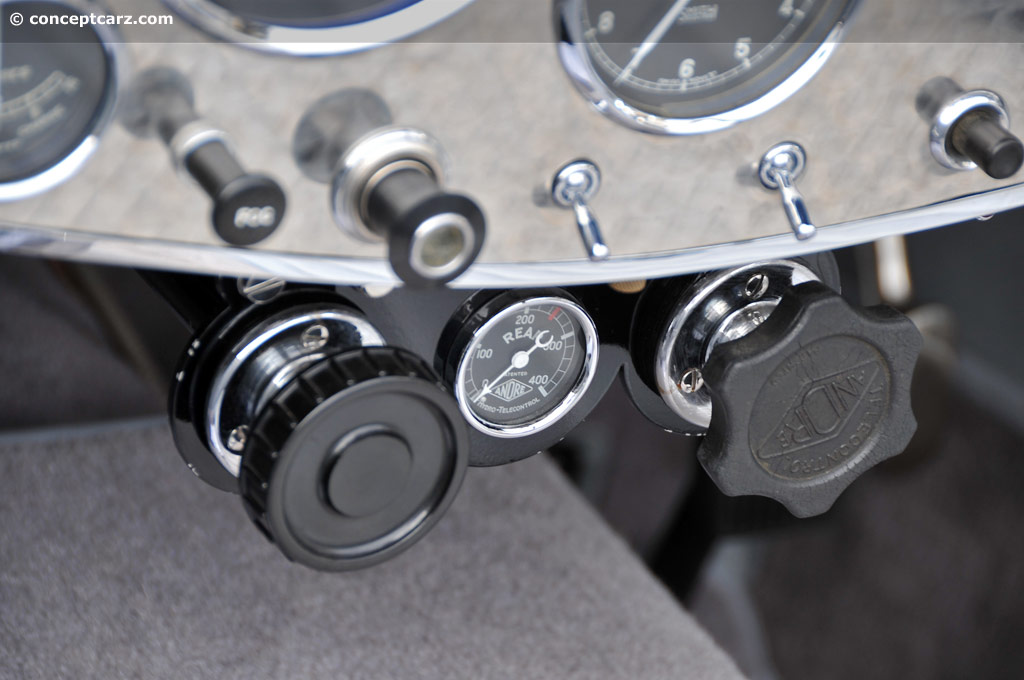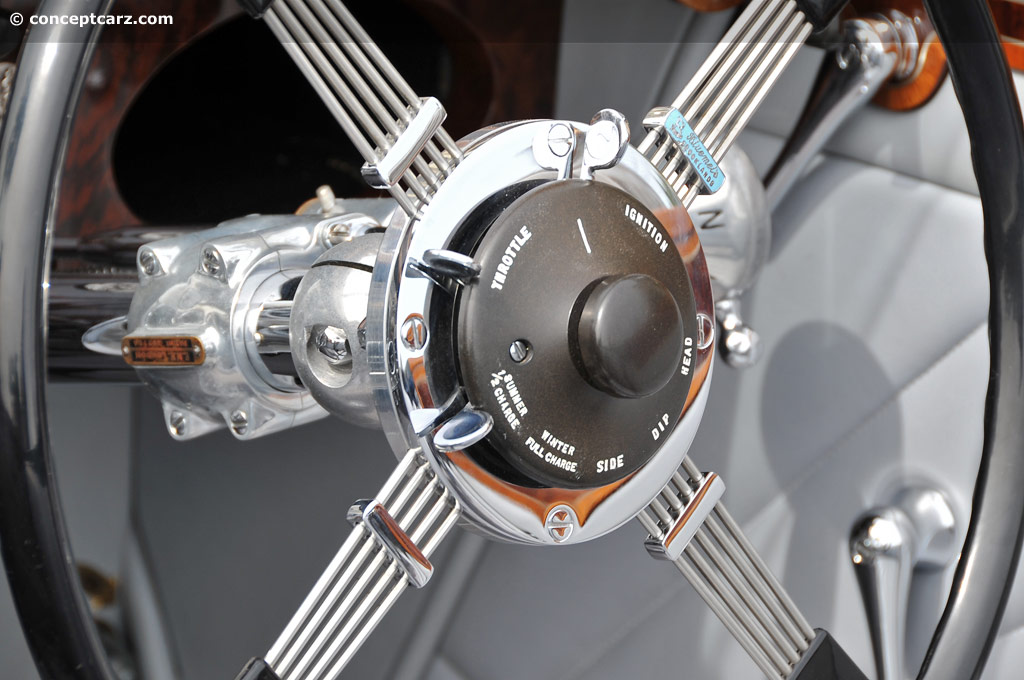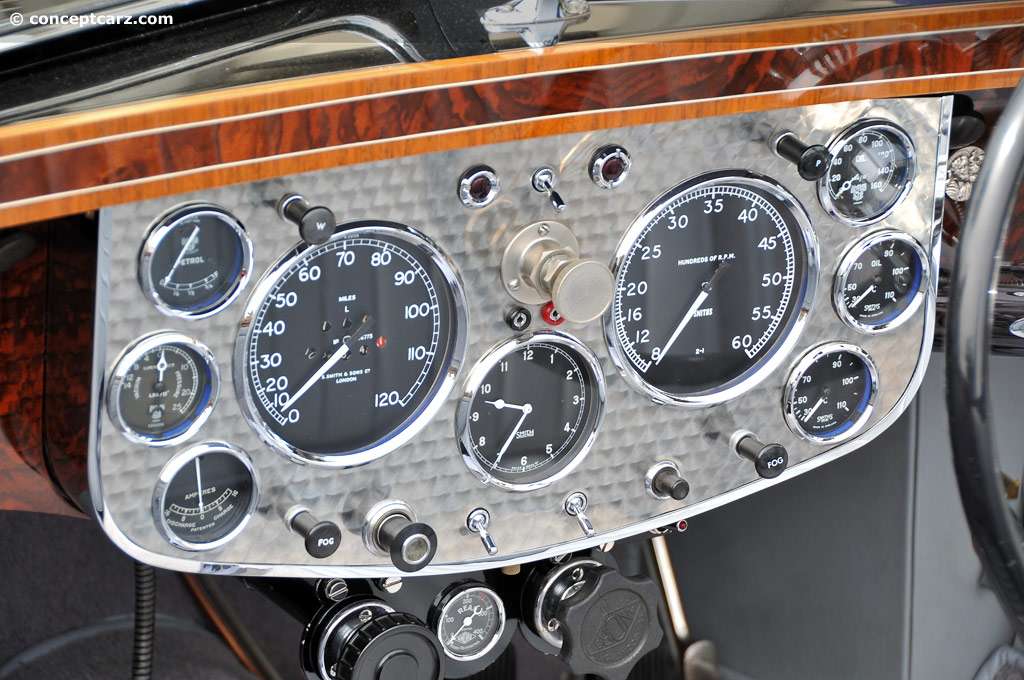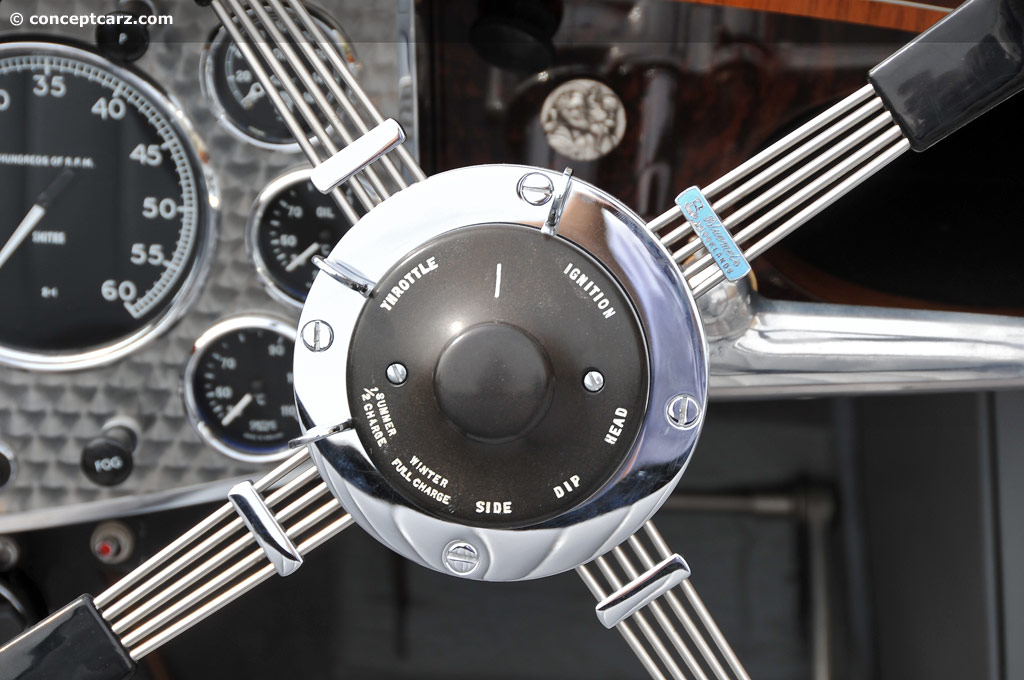Image credit: © conceptcarz.com (Reproduction Or reuse prohibited).
In the 1930s, English engineer Adrian Squire dreamed of building the greatest sports car in the world. He was in competition with Bugatti and Alfa Romeo and the all-new Squire was similar in many ways. All three utilized twin-overhead cam, supercharged engines fitted to iron frames with a variety of light and open coachwork. The Bugatti and Alfa Romeo used a flexible stiffy-sprung chassis while Squire the opposite, a rigid and heavily reinforced unit that was softly sprung. This design and suspension gave the Squire an ultra-low center of gravity. Rather than using traditional rod and cable brakes, Squire went with dual-circuit hydraulic brakes coupled to massive 15-inch magnesium drums on all four corners. Handling and braking were light-years ahead of rival manufacturers. Squire also insisted on the use of a pre-selector gearbox, which was heavier, but provided precise gear selection every time.
Just 10 Squires were completed from 1934 to 1938. Today, nine of those still survive. In the end, Adrian Squire's dream came at far too dear a price than could be supported by the troubled economics of the 1930s.
This example is the eighth built and the sole example executed with coachwork by Corisca of Grimaldi Street in London.
Just 10 Squires were completed from 1934 to 1938. Today, nine of those still survive. In the end, Adrian Squire's dream came at far too dear a price than could be supported by the troubled economics of the 1930s.
This example is the eighth built and the sole example executed with coachwork by Corisca of Grimaldi Street in London.
A true sportscar is to be that alluring blend of luxury and performance. And for a brief period during the 1930s, a small manufacturer by the name of Squire Car Manufacturing Company was considered one of the very few to produce some truly amazing automobiles that combined spine-tingling performance with elegant design.
Adrian Squire would work with some of the best sportscar manufacturers even before he turned 21. As an employee of both Bentley and MG, Squire would learn firsthand about the elements that go into creating a truly memorable car. But working for factories building such cars wasn't good enough for Squire. And for one reason: they didn't design and build his idea of a great sportscar.
Squire already had an idea of what the ultimate sportscar would look like. Even as a schoolboy, at the young age of 16, Squire would sketch designs. He eventually would create a whole catalogue of what he believed to be the 'world's greatest sports car'.
Even at a young age, Squire knew all of the necessary elements needed to make a great sports car. He envisioned a design with a chassis that had a low center of gravity. And in an era filled boxy designs, Adrian thought only of sleek, flowing bodywork that was light and that combined aesthetics with function.
Bentley and MG were noted for developing some of the best cars and Squire were right there helping to develop and build them. At the young age of 18, Adrian worked as an apprentice with Bentley Motors. He would later work as an assistant draftsman at MG. But like many young people in the world, Squire believed he could do better. For his 21st birthday, Adrian would receive an inheritance of £20,000, and he knew exactly what he was to do with it. Therefore, at just 21 years of age, he would go on to form Squire Motors Ltd. in 1931.
Based in Henley-on-Thames in Oxfordshire, Squire would set to work designing his ultimate sports car. But the process was destined to take a while longer if Squire didn't get a little bit. That help would come from another manufacturer. Frazer-Nash had British Anzani engines at their disposal but would decide to forego them for another option. The 1.5-liter DOHC 4-cylinder engine had been designed by Frazer-Nash's T.D. Ross. The production of the engine was then handled by Anzani.
But what was Frazer-Nash's loss would be Squire's gain and he would immediately have the engines cast with the name 'Squire' in the block and manifold. Just like that, Adrian had his engine for use with his design. But the engine needed more power, according to Adrian. Therefore David Brown would be commissioned with building the engines to accept a Roots-type supercharger. This would boost the horsepower up to a rather robust 110 bhp.
With the engine making headway, Squire would set about preparing the rest of the chassis. He would turn to a Wilson-type preselector gearbox and an E.N.V. live rear axle. The car would have a solid front axle with semi-elliptic leaf springs at the front and rear. Braking power for the car would come from four-wheel hydraulic drum brakes that used huge 15-inch magnesium alloy drums.
Some additional features Adrian's car would offer would include the use of adjustable friction shock absorbers. This allowed control override and handling. With the incredibly rigid chassis finished, Squire would ship the car off to Vanden Plas to create the sleek and flowing bodies that Adrian had always envisioned.
When it was Squire would get just about what he wanted. But he would find out his vision of the 'world's greatest sports car' would be very expensive. In fact, it would be so expensive he would turn instead to H. Markham, Ltd. to create less-expensive bodies.
As a result of the cost of his cars, which were nearly the same as a Bugatti, Squire would sell few cars. The first one would be bought in 1935. And by 1936, Squire would be shutting his doors to go work for Lagonda.
However, in 1935, before Squire shut his doors and went to work for Lagonda, he would sell the last car he ever built. The car would go to Val Zethrin of Chislehurst. Zethrin would end up becoming a prominent player in the final chapter of Squire's history.
During its short existence, however, Squire Car Manufacturing Company, Ltd. would earn a place of unmatched supremacy. For its time, Squire's sports cars would achieve performance numbers better than just about every other car known to exist at the time, and the advancements of design and handling as a result of Adrian's understanding and talent have led many to consider his cars to surely be the best sports cars in their time.
Adrian's understanding of what made for a great sports car would be undisputed just with an investigative look at his chassis' design. Adrian's understanding of how lower centers of gravity help to prevent roll and any other uncontrolled movement was truly genius. The way the suspension stiffened under loading to its superior braking power that exceeded every other car of the period, including cars produced well into the 1950s and '60s, it was clear Squire understood what made for a great sports car. And when the braking and handling were applied to the 110 bhp, Squire had all the makings of a super car. He just couldn't produce it cheap enough to sustain its production and further development.
After closing his doors, Squire would go to work for Lagonda throughout the rest of the 1930s. Then, just prior to the outbreak of World War II, he would go on to work for the Bristol Aeroplane Company. Unfortunately, during the beginning days of the Second World War, during the Battle of Britain, England's airplane manufacturing facilities were strategic targets for German bombing. And during one bombing raid against the Bristol Aeroplane Company in 1940, Squire would be killed.
In the last couple of years leading up to his death, Squire's place in automotive manufacturing history would be completed by Zethrin. Upon closing, there would still be enough components to build a further three cars. Zethrin would purchase the rest of the components and would have the final three cars built.
One of those final three would be offered at this year's Amelia Island RM Auctions. Chassis 1063 would be the first of the final three to be built. Actually, the car had begun the process of being built just prior to Squire closing his doors. It just wasn't finished. Zethrin's presence, however, would change the direction of the coachwork applied to Squire's superior chassis.
Instead of approaching Vanden Plas or H. Markham, Ltd. once again, Zethrin would employ the small London coachbuilder Corsica. Corsica coachworks had been established at Kings Cross in London in 1920 by Charles Stammers and Joseph and Robert Lee. In a story similar to Squire's, Corsica would never re-open its doors at the conclusion of World War II as a result of two of its founders having died during the war.
However, while it was operating, this small firm was anything but a small player in the coachbuilding scene. The company was known for creating beautiful, low-slung sporting bodies for Daimler. But it would also build coaches for Bugatti, Isotta Fraschini, Mercedes-Benz, and just about every British marque known to exist at the time. However, during its time of working with these many different manufacturers, Corsica would come up with a design for a drophead coupe, but it was placed on the chassis of a K-Type Magnette.
The size of the Corsica firm would actually be to its advantage as it would allow it to work closely with the customers creating a design based directly around their desires and whims. This meant the company could include designs and features inspired by the customer instead of the firm determining the look and feel of the car. This meant each one of their cars and a very personal feel to it. But for this first of the three chassis left by Squire, Corsica would return to its sleek drophead coupe design and would make one specifically for chassis 1063. This would make chassis 1063 truly unique as every other chassis before it had been graced with a touring coach design.
In September of 1937, the first of the final three chassis would be finished and it would be delivered with British registration BGB 34 to Glasgow. Little would be known of the car but at some time it would come to be the property of Cameron Millar. Then, in December of 1984, the car was exported to the United States as a result of being sold to Dr. Douglas Oosterhaut, a prominent plastic surgeon in the San Francisco area.
Over the course of its two years with Dr. Oosterhaut the car would be regularly driven. Then, in 1986, the car would be purchased by Bob Cole. Cole would own and operated the car for about a decade before passing it on to his son Rob, proprietor of Cole Classic Corporation. During its time with Bob Cole, the car would be regularly taken care of and serviced by Phil Reilly and Company.
Bob passed the Squire on to his son in 1995. In that same year, the car would be sold to collector Pat Hart from the state of Washington. Under Hart's ownership, the car would undergo an extensive restoration performed by Don Vogelsang in Seattle. During this restoration, Vogelsang would make some minor alterations to the body but would keep to the spirit of the car's design.
The finished car would then go on to make its debut at the 1998 Pebble Beach Concours d'Elegance. The car has remained part of Hart's personal collection from that day on until his death in 2002.
Upon his death, the car was stored and would not appear again until 2010 when it appeared at The Quail, a Motorsports Gathering, at Quail Lodge. Rightly displayed at the event in Carmel, California, the Squire would not find its way back to long-term storage for its current owner would come to purchase the car just a short time later.
Upon being received by its current owner, the Drophead Coupe would be returned to running order and would be seen numerous times throughout the 2011 show season. At Palm Beach, the car would be voted as the People's Choice and Best of Show at Classic Sports Sunday at Mar-a-Lago. It would later receive the Breitling Award for Timeless Beauty at Amelia Island. Its final couple of awards would come in Pasadena and Del Mar, California. At the Art Center College of Design in Pasadena, the squire would receive the Designers' Choice award. Then at Del Mar, the car would finish Best in Class. Beautifully presented in an all-black finish with just enough chrome to make the car really stand out to the eye of the beholder, it would be understandable why it would receive such acclaim and such prestigious awards.
This multi-award winner would begin the 2012 season being offered for sale at RM Auctions' Amelia Island event. Heading into the event, this truly special Squire was certain to draw the attention of many onlookers and was expected to demand a great sale price.
And as the car drove up and the bidding began it was clear the bidders were fighting for a truly special, rare, and momentous car. For while it was well known there were only 10 Squires ever built, this particular one existed in a world all its own. Not only was the car fitted with the most advanced and best handling chassis of its day, but it is also rare as it is the only Squire to be fitted with a Corsica body. But to top it all off, its truly unique body styling beautifully represents that bridge between the hope and the final death of Squire's dream. And with multiple awards, this Squire Drophead Coupe would deservedly sell for a price of $990,000.
Truly a work of art to behold and an incredible performer, even to this day. Truly Squire created one of the world's greatest sports cars.
Sources:
'Lot No. 166: 1937 Squire 1 ½-liter Drophead Coupe by Corsica', (http://www.rmauctions.com/CarDetails.cfm?SaleCode=AM12&CarID=r117&Currency=USD). RM Auctions. http://www.rmauctions.com/CarDetails.cfm?SaleCode=AM12&CarID=r117&Currency=USD. Retrieved 15 March 2012.
'1937 Squire 1.5-Liter Drophead Coupe by Corsica', (http://classiccarweekly.wordpress.com/2012/02/23/squire-drophead-coupe/). Classic Car Weekly. http://classiccarweekly.wordpress.com/2012/02/23/squire-drophead-coupe/. Retrieved 15 March 2012.
'The Coachbuilders Encyclopedia: Corsica', (http://www.coachbuild.com/index.php?option=com_gallery2&Itemid=50&g2_itemId=42931). Coachbuilder.com. http://www.coachbuild.com/index.php?option=com_gallery2&Itemid=50&g2_itemId=42931. Retrieved 15 March 2012.
'Squire 1500: 1935-1939 Squire 1500', (http://www.supercars.net/cars/3063.html). Supercars.net. http://www.supercars.net/cars/3063.html. Retrieved 15 March 2012.
Wikipedia contributors, 'Squire Car Manufacturing Company', Wikipedia, The Free Encyclopedia, 24 October 2011, 19:35 UTC, http://en.wikipedia.org/w/index.php?title=Squire_Car_Manufacturing_Company&oldid=457197761 accessed 15 March 2012
'British Motor Manufacturers (1894-1960): Squire', (http://www.britishmm.co.uk/history.asp?id=836). British Motor Manufacturers. http://www.britishmm.co.uk/history.asp?id=836. Retrieved 15 March 2012.
By Jeremy McMullen
Adrian Squire would work with some of the best sportscar manufacturers even before he turned 21. As an employee of both Bentley and MG, Squire would learn firsthand about the elements that go into creating a truly memorable car. But working for factories building such cars wasn't good enough for Squire. And for one reason: they didn't design and build his idea of a great sportscar.
Squire already had an idea of what the ultimate sportscar would look like. Even as a schoolboy, at the young age of 16, Squire would sketch designs. He eventually would create a whole catalogue of what he believed to be the 'world's greatest sports car'.
Even at a young age, Squire knew all of the necessary elements needed to make a great sports car. He envisioned a design with a chassis that had a low center of gravity. And in an era filled boxy designs, Adrian thought only of sleek, flowing bodywork that was light and that combined aesthetics with function.
Bentley and MG were noted for developing some of the best cars and Squire were right there helping to develop and build them. At the young age of 18, Adrian worked as an apprentice with Bentley Motors. He would later work as an assistant draftsman at MG. But like many young people in the world, Squire believed he could do better. For his 21st birthday, Adrian would receive an inheritance of £20,000, and he knew exactly what he was to do with it. Therefore, at just 21 years of age, he would go on to form Squire Motors Ltd. in 1931.
Based in Henley-on-Thames in Oxfordshire, Squire would set to work designing his ultimate sports car. But the process was destined to take a while longer if Squire didn't get a little bit. That help would come from another manufacturer. Frazer-Nash had British Anzani engines at their disposal but would decide to forego them for another option. The 1.5-liter DOHC 4-cylinder engine had been designed by Frazer-Nash's T.D. Ross. The production of the engine was then handled by Anzani.
But what was Frazer-Nash's loss would be Squire's gain and he would immediately have the engines cast with the name 'Squire' in the block and manifold. Just like that, Adrian had his engine for use with his design. But the engine needed more power, according to Adrian. Therefore David Brown would be commissioned with building the engines to accept a Roots-type supercharger. This would boost the horsepower up to a rather robust 110 bhp.
With the engine making headway, Squire would set about preparing the rest of the chassis. He would turn to a Wilson-type preselector gearbox and an E.N.V. live rear axle. The car would have a solid front axle with semi-elliptic leaf springs at the front and rear. Braking power for the car would come from four-wheel hydraulic drum brakes that used huge 15-inch magnesium alloy drums.
Some additional features Adrian's car would offer would include the use of adjustable friction shock absorbers. This allowed control override and handling. With the incredibly rigid chassis finished, Squire would ship the car off to Vanden Plas to create the sleek and flowing bodies that Adrian had always envisioned.
When it was Squire would get just about what he wanted. But he would find out his vision of the 'world's greatest sports car' would be very expensive. In fact, it would be so expensive he would turn instead to H. Markham, Ltd. to create less-expensive bodies.
As a result of the cost of his cars, which were nearly the same as a Bugatti, Squire would sell few cars. The first one would be bought in 1935. And by 1936, Squire would be shutting his doors to go work for Lagonda.
However, in 1935, before Squire shut his doors and went to work for Lagonda, he would sell the last car he ever built. The car would go to Val Zethrin of Chislehurst. Zethrin would end up becoming a prominent player in the final chapter of Squire's history.
During its short existence, however, Squire Car Manufacturing Company, Ltd. would earn a place of unmatched supremacy. For its time, Squire's sports cars would achieve performance numbers better than just about every other car known to exist at the time, and the advancements of design and handling as a result of Adrian's understanding and talent have led many to consider his cars to surely be the best sports cars in their time.
Adrian's understanding of what made for a great sports car would be undisputed just with an investigative look at his chassis' design. Adrian's understanding of how lower centers of gravity help to prevent roll and any other uncontrolled movement was truly genius. The way the suspension stiffened under loading to its superior braking power that exceeded every other car of the period, including cars produced well into the 1950s and '60s, it was clear Squire understood what made for a great sports car. And when the braking and handling were applied to the 110 bhp, Squire had all the makings of a super car. He just couldn't produce it cheap enough to sustain its production and further development.
After closing his doors, Squire would go to work for Lagonda throughout the rest of the 1930s. Then, just prior to the outbreak of World War II, he would go on to work for the Bristol Aeroplane Company. Unfortunately, during the beginning days of the Second World War, during the Battle of Britain, England's airplane manufacturing facilities were strategic targets for German bombing. And during one bombing raid against the Bristol Aeroplane Company in 1940, Squire would be killed.
In the last couple of years leading up to his death, Squire's place in automotive manufacturing history would be completed by Zethrin. Upon closing, there would still be enough components to build a further three cars. Zethrin would purchase the rest of the components and would have the final three cars built.
One of those final three would be offered at this year's Amelia Island RM Auctions. Chassis 1063 would be the first of the final three to be built. Actually, the car had begun the process of being built just prior to Squire closing his doors. It just wasn't finished. Zethrin's presence, however, would change the direction of the coachwork applied to Squire's superior chassis.
Instead of approaching Vanden Plas or H. Markham, Ltd. once again, Zethrin would employ the small London coachbuilder Corsica. Corsica coachworks had been established at Kings Cross in London in 1920 by Charles Stammers and Joseph and Robert Lee. In a story similar to Squire's, Corsica would never re-open its doors at the conclusion of World War II as a result of two of its founders having died during the war.
However, while it was operating, this small firm was anything but a small player in the coachbuilding scene. The company was known for creating beautiful, low-slung sporting bodies for Daimler. But it would also build coaches for Bugatti, Isotta Fraschini, Mercedes-Benz, and just about every British marque known to exist at the time. However, during its time of working with these many different manufacturers, Corsica would come up with a design for a drophead coupe, but it was placed on the chassis of a K-Type Magnette.
The size of the Corsica firm would actually be to its advantage as it would allow it to work closely with the customers creating a design based directly around their desires and whims. This meant the company could include designs and features inspired by the customer instead of the firm determining the look and feel of the car. This meant each one of their cars and a very personal feel to it. But for this first of the three chassis left by Squire, Corsica would return to its sleek drophead coupe design and would make one specifically for chassis 1063. This would make chassis 1063 truly unique as every other chassis before it had been graced with a touring coach design.
In September of 1937, the first of the final three chassis would be finished and it would be delivered with British registration BGB 34 to Glasgow. Little would be known of the car but at some time it would come to be the property of Cameron Millar. Then, in December of 1984, the car was exported to the United States as a result of being sold to Dr. Douglas Oosterhaut, a prominent plastic surgeon in the San Francisco area.
Over the course of its two years with Dr. Oosterhaut the car would be regularly driven. Then, in 1986, the car would be purchased by Bob Cole. Cole would own and operated the car for about a decade before passing it on to his son Rob, proprietor of Cole Classic Corporation. During its time with Bob Cole, the car would be regularly taken care of and serviced by Phil Reilly and Company.
Bob passed the Squire on to his son in 1995. In that same year, the car would be sold to collector Pat Hart from the state of Washington. Under Hart's ownership, the car would undergo an extensive restoration performed by Don Vogelsang in Seattle. During this restoration, Vogelsang would make some minor alterations to the body but would keep to the spirit of the car's design.
The finished car would then go on to make its debut at the 1998 Pebble Beach Concours d'Elegance. The car has remained part of Hart's personal collection from that day on until his death in 2002.
Upon his death, the car was stored and would not appear again until 2010 when it appeared at The Quail, a Motorsports Gathering, at Quail Lodge. Rightly displayed at the event in Carmel, California, the Squire would not find its way back to long-term storage for its current owner would come to purchase the car just a short time later.
Upon being received by its current owner, the Drophead Coupe would be returned to running order and would be seen numerous times throughout the 2011 show season. At Palm Beach, the car would be voted as the People's Choice and Best of Show at Classic Sports Sunday at Mar-a-Lago. It would later receive the Breitling Award for Timeless Beauty at Amelia Island. Its final couple of awards would come in Pasadena and Del Mar, California. At the Art Center College of Design in Pasadena, the squire would receive the Designers' Choice award. Then at Del Mar, the car would finish Best in Class. Beautifully presented in an all-black finish with just enough chrome to make the car really stand out to the eye of the beholder, it would be understandable why it would receive such acclaim and such prestigious awards.
This multi-award winner would begin the 2012 season being offered for sale at RM Auctions' Amelia Island event. Heading into the event, this truly special Squire was certain to draw the attention of many onlookers and was expected to demand a great sale price.
And as the car drove up and the bidding began it was clear the bidders were fighting for a truly special, rare, and momentous car. For while it was well known there were only 10 Squires ever built, this particular one existed in a world all its own. Not only was the car fitted with the most advanced and best handling chassis of its day, but it is also rare as it is the only Squire to be fitted with a Corsica body. But to top it all off, its truly unique body styling beautifully represents that bridge between the hope and the final death of Squire's dream. And with multiple awards, this Squire Drophead Coupe would deservedly sell for a price of $990,000.
Truly a work of art to behold and an incredible performer, even to this day. Truly Squire created one of the world's greatest sports cars.
Sources:
'Lot No. 166: 1937 Squire 1 ½-liter Drophead Coupe by Corsica', (http://www.rmauctions.com/CarDetails.cfm?SaleCode=AM12&CarID=r117&Currency=USD). RM Auctions. http://www.rmauctions.com/CarDetails.cfm?SaleCode=AM12&CarID=r117&Currency=USD. Retrieved 15 March 2012.
'1937 Squire 1.5-Liter Drophead Coupe by Corsica', (http://classiccarweekly.wordpress.com/2012/02/23/squire-drophead-coupe/). Classic Car Weekly. http://classiccarweekly.wordpress.com/2012/02/23/squire-drophead-coupe/. Retrieved 15 March 2012.
'The Coachbuilders Encyclopedia: Corsica', (http://www.coachbuild.com/index.php?option=com_gallery2&Itemid=50&g2_itemId=42931). Coachbuilder.com. http://www.coachbuild.com/index.php?option=com_gallery2&Itemid=50&g2_itemId=42931. Retrieved 15 March 2012.
'Squire 1500: 1935-1939 Squire 1500', (http://www.supercars.net/cars/3063.html). Supercars.net. http://www.supercars.net/cars/3063.html. Retrieved 15 March 2012.
Wikipedia contributors, 'Squire Car Manufacturing Company', Wikipedia, The Free Encyclopedia, 24 October 2011, 19:35 UTC, http://en.wikipedia.org/w/index.php?title=Squire_Car_Manufacturing_Company&oldid=457197761 accessed 15 March 2012
'British Motor Manufacturers (1894-1960): Squire', (http://www.britishmm.co.uk/history.asp?id=836). British Motor Manufacturers. http://www.britishmm.co.uk/history.asp?id=836. Retrieved 15 March 2012.
By Jeremy McMullen
2012 RM Auctions at Amelia Island, Fla
Sale Price :
USD $990,000
Recent Sales of the Squire 1600
(Data based on Model Year 1937 sales)
| 1937 Squire 1½-Liter Drophead Coupe Chassis#: 1063 Sold for USD$990,000 2012 RM Auctions at Amelia Island, Fla |   |
Squire 1600s That Failed To Sell At Auction
1937 Squire 1600's that have appeared at auction but did not sell.
| Vehicle | Chassis | Event | High Bid | Est. Low | Est. High |
|---|
Vehicles With Comparable Market Values
Similar sales to the $990,000 range.
| 1956 Ferrari 250 GT Coupé Prototype by Pinin Farina Chassis#:0435 GT Sold for $994,623 2024 RM Sothebys : Paris | |
| 2021 Ford GT Carbon Series Chassis#:2fagp9dwxmh200162 Sold for $990,000 2024 Mecum : Kissimmee | |
| 1973 Porsche 911 Carrera RS 2.7 Touring Chassis#:9113601235 Sold for $989,500 2023 RM Sothebys : The White Collection | |
| 1994 Porsche 911 Turbo S X85 'Flat-Nose' Chassis#:WP0AC2964RS480446 Sold for $995,000 2023 RM Sothebys : Las Vegas | |
| 1961 JAGUAR E-TYPE SERIES I 3.8-LITRE ROADSTER Chassis#:850004 Sold for $983,049 2023 Gooding & Company : London Auction | |
| 2021 Ford GT Chassis#:2FAGP9CWXMH200146 Sold for $995,000 2023 Broad Arrow : Monterey Jet Center | |
| 2020 Ferrari 488 Pista 'Piloti Ferrari' Chassis#:ZFF90HLA4L0255024 Sold for $995,000 2023 RM Sothebys : Monterey | |
| 2019 FORD GT LIGHTWEIGHT EDITION Chassis#:2FAGP9CW8KH200238 Sold for $990,000 2023 Barrett-Jackson : Las Vegas | |
| 2020 FORD GT Chassis#:2FAGP9CW8LH100044 Sold for $990,000 2023 Barrett-Jackson : Palm Beach | |
| 2020 Ford GT MkII Sold for $990,000 2023 Mecum : Kissimmee | |
| 1993 Lola-Ford Cosworth T93/00 Chassis#:HU 05 Sold for $995,000 2022 RM Sothebys : The House That Newman/Haas Racing Built | |
| 2019 FORD GT Chassis#:2FAGP9CWXKH200046 Sold for $990,000 2022 Barrett-Jackson : Houston | |
| 1964 Shelby 289 Cobra Chassis#:CSX 2171 Sold for $995,000 2022 Broad Arrow Auctions : The Passion for the Drive |   |
| 1968 Lamborghini Miura P400 by Bertone Chassis#:3435 Sold for $995,000 2022 RM Sothebys : Monterey |   |
| 1968 Maserati Ghibli Spyder Prototype by Ghia Chassis#:AM115/S 1001 Sold for $995,000 2022 RM Sothebys : Monterey |   |
| 1926 Bugatti 37A ex-Jacques Dufilho Chassis#:37211 Sold for $987,388 2022 Artcurial : Retromobile | |
| 1970 PLYMOUTH HEMI SUPERBIRD Chassis#:RM23R0A162305 Sold for $990,000 2022 Barrett-Jackson : Scottsdale, Arizona | |
| 1959 MERCEDES-BENZ 300SL ROADSTER Chassis#:198042109500027 Sold for $990,000 2022 Barrett-Jackson : Scottsdale, Arizona | |
| 2017 Ford GT Sold for $990,000 2022 Mecum : Kissimmee | |
| 1966 Shelby Cobra 427 Chassis#:CSX3205 Sold for $995,000 2021 Bonhams : Quail Lodge |  |
1937 Squire 1600
• Additional valuation insight and sales data• History
• Specifications
• Image gallery
